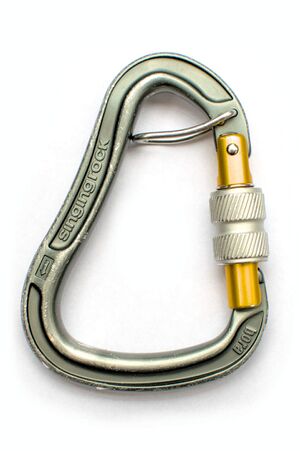Carabiner
Carabiners are nowadays as essential for the mountaineering and climbing as a rope. Types of carabiners used in climbing and their applications are discussed in-detail below.
| Carabiner | |
|---|---|
 | |
| Other names | Biner |
| Use(s) | Everywhere |
Review state This page has not been reviewed yet (review state explanation). |
Safe-use recommendations
Certified climbing carabiners are generally very safe if used properly. However, in some cases their strength and reliability gets compromised by improper handling. In addition, for specific applications, climbing associations recommends using carabiners with increased gate-opening protection.
Prevent carabiners from cross-loading. They are often still able to withstand up to ~7 kN of force, but that is only a fraction of their nominal strength. With wired-gate carabiners, cross-loading might in-addition induce a rope strain if the rope is loaded over the gate. Prevent placing the carabiner in a way that its gate faces towards the rock and/or the rock features, it might result in opening the gate. You can prevent this by orienting the carabiner so that the gate points in a free direction.[1]
Do not place carabiners in a way that they would get loaded over a rock edge. HowNOT2 recorded a measurement where he cracked a sideway-loaded carabiner below 4 kN.[2] That is roughly half of the force a carabiner placed in the last protection piece experiences during a catch of a big lead fall. Therefore there is a very realistic chance the carabiner loaded over an edge might fail during a lead-climb fall. If you want to secure yourself to an inconviently placed bolt or a piton, extend it by a sling or a rope as illustrated below.[3]
Gate types
Full-gate carabiners
Full-gate carabiners are considered the normal carabiners. In contrast to wire-gate carabiners they are not prone to getting things stuck in their entrance because of their more favourable nose shape. They might be prone to whipsplash (opening of the gate in case of a suddenly-stopped move). They are mostly seen in quickdraws on the bolt side, or no both sides. They are useful for carrying trad climbing protection pieces with wires.
Wire-gate carabiners
Wire gate carabiners are slightly lighter than their full-gate counterparts. They are less prone to freezing and if they freeze, they can be cleaned easily. They are also way less prone to a gate lash. However, wire gates might get pulled-out sideways. Loading of a wire gate with a rope during an accident can damage the rope (very small bend radius). Nose groove of the wire-gate carabiner can get caught in bolt hangers, in wires of the trad protection pieces (nuts, hexes etc), or smaller diameter slings and cords. Some of the issues were addressed by single-wire carabiners. For their freezing resistance, wire-gate carabiners are employed in ice climbing. They are also employed in quickdraws for sport- and trad-climbing - either on the rope side, or on both sides.
Screw-gate carabiners
Screw-gate carabiners provide increased security. They are mainly employed in anchor setups, belaying, and in rescue techniques. As screwing and unscrewing the gate takes time, screw-gate carabiners are generally not used in quickdraws for clipping bolts along the route, except of a few special cases.
Safety carabiners
Safety carabiners are used especially for attaching climbers to the rope and for belaying. Some climbers use them on lanyard and while building an anchor. Unlike screw-gate carabiners they have various additional safety features which prevents the gate from opening and usually locks themself automatically - twistlock (double-action), triple-lock and ball-lock (triple action) and even quadruple action carabiners.
Shape types
D-shaped carabiners
D-shape carabiner (nowadays most often the asymmetric D-shape) is the most used carabiner shape. The D-shape provides high loading capacity and naturally positions the rope on the carabiner into a well defined spot. They are used in anchor building, quickdraws and other places.
HMS carabiners
HMS carabiners have the side for the rope much wider providing enough of space for belaying device or Munter hitch after which they were named (from german HalbMastwurfSicherung). Because they are spacious, they are often employed as the central carabiner in the anchors. Some HMS carabiners have very atypical shapes intended to prevent cross-loading.
Oval carabiners
Handy in aid climbing, or for carrying material.
References
- ↑ Ocun (May 28, 2025). "Instructions for the use of connectors EN 566 and carabiners (EN 12275). (v250520)" (PDF). Ocun.com/service/instructions. Ocun (RP Climbing s.r.o.). Retrieved 1 September 2025.
- ↑ Jenks, Ryan (7 June 2021). Carabiners Loaded Sideways!?!?. HowNOT2. Retrieved 1 September 2025.
- ↑ Kublák, Tomáš. "Karabiny v Jištění (Carabiners in protection)". Horolezeckametodika.cz. HOROLEZECKÁ METODIKA. Retrieved 1 September 2025.